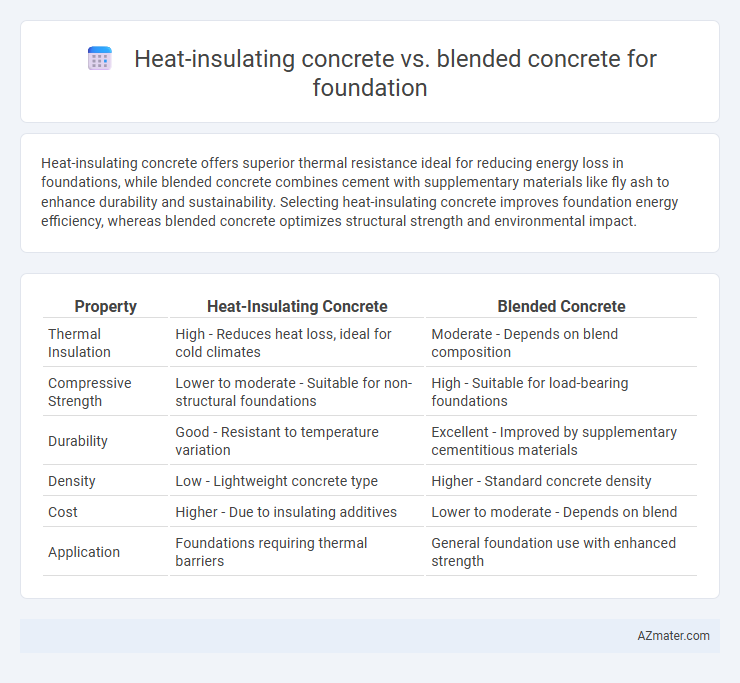Heat-insulating concrete offers superior thermal resistance ideal for reducing energy loss in foundations, while blended concrete combines cement with supplementary materials like fly ash to enhance durability and sustainability. Selecting heat-insulating concrete improves foundation energy efficiency, whereas blended concrete optimizes structural strength and environmental impact.
Table of Comparison
| Property | Heat-Insulating Concrete | Blended Concrete |
|---|---|---|
| Thermal Insulation | High - Reduces heat loss, ideal for cold climates | Moderate - Depends on blend composition |
| Compressive Strength | Lower to moderate - Suitable for non-structural foundations | High - Suitable for load-bearing foundations |
| Durability | Good - Resistant to temperature variation | Excellent - Improved by supplementary cementitious materials |
| Density | Low - Lightweight concrete type | Higher - Standard concrete density |
| Cost | Higher - Due to insulating additives | Lower to moderate - Depends on blend |
| Application | Foundations requiring thermal barriers | General foundation use with enhanced strength |
Understanding Heat-Insulating Concrete
Heat-insulating concrete for foundations features enhanced thermal resistance through additives such as expanded perlite, vermiculite, or aerogel, reducing heat transfer and improving energy efficiency in buildings. This type of concrete maintains structural integrity while minimizing thermal bridging, making it ideal for cold climates or energy-conscious designs. Blended concrete typically combines Portland cement with supplementary cementitious materials like fly ash or slag to improve strength and durability but lacks the inherent thermal insulation properties of heat-insulating concrete.
What is Blended Concrete?
Blended concrete is a mixture that combines Portland cement with supplementary cementitious materials such as fly ash, slag, or silica fume to enhance durability, reduce environmental impact, and improve workability. Compared to heat-insulating concrete, which prioritizes thermal resistance through the addition of insulating aggregates or materials, blended concrete focuses on strength and sustainability while maintaining adequate thermal properties. This makes blended concrete a versatile and eco-friendly choice for foundations requiring both structural integrity and moderate insulation.
Key Properties Comparison
Heat-insulating concrete provides superior thermal resistance with a lower thermal conductivity value, typically ranging from 0.1 to 0.3 W/mK, which helps maintain stable foundation temperatures and reduces energy loss. Blended concrete, incorporating supplementary cementitious materials such as fly ash or slag, enhances durability, compressive strength (often above 40 MPa), and resistance to chemical attacks, but generally exhibits higher thermal conductivity between 0.8 to 1.2 W/mK. The choice between heat-insulating and blended concrete for foundations depends on prioritizing either enhanced thermal insulation for energy efficiency or improved mechanical performance and longevity under environmental stress.
Thermal Performance in Foundations
Heat-insulating concrete offers superior thermal resistance with its low thermal conductivity, effectively minimizing heat loss in foundation applications, which enhances energy efficiency in buildings. Blended concrete, incorporating materials like fly ash or slag, improves thermal mass properties, allowing it to absorb and slowly release heat, contributing to temperature regulation but with moderate insulation compared to heat-insulating variants. Choosing heat-insulating concrete for foundations is optimal for climates requiring enhanced thermal barriers, whereas blended concrete serves well in balancing durability and moderate thermal performance.
Structural Strength and Durability
Heat-insulating concrete typically incorporates lightweight aggregates or insulating additives, which may slightly reduce compressive strength compared to blended concrete but significantly improves thermal performance in foundation applications. Blended concrete, combining Portland cement with supplementary cementitious materials like fly ash or slag, enhances structural strength and durability by refining the microstructure and increasing resistance to chemical attacks and freeze-thaw cycles. For foundation use, blended concrete generally offers superior load-bearing capacity and long-term durability, while heat-insulating concrete is advantageous where thermal regulation and energy efficiency are prioritized.
Cost Analysis and Economic Impact
Heat-insulating concrete reduces long-term energy expenses by enhancing thermal resistance in foundations, resulting in lower heating and cooling costs. Blended concrete, combining cement with supplementary materials like fly ash or slag, lowers initial material costs and reduces carbon footprint, offering immediate economic benefits. Comparing both, heat-insulating concrete shows higher upfront costs but greater lifetime savings, while blended concrete provides cost efficiency in construction with moderate impact on operational costs.
Environmental Sustainability Factors
Heat-insulating concrete reduces energy consumption by enhancing thermal resistance in foundation structures, leading to lower heating and cooling demands that significantly decrease carbon emissions over the building's lifecycle. Blended concrete incorporates supplementary cementitious materials like fly ash or slag, which lower cement content and reduce CO2 emissions during production, contributing to sustainable resource use and waste reduction. Choosing either material promotes environmental sustainability through improved energy efficiency or decreased embodied carbon in foundational construction.
Installation and Workability Considerations
Heat-insulating concrete offers enhanced thermal resistance, reducing energy transfer in foundation applications, but tends to be lighter and can require specialized handling to maintain its insulating properties during installation. Blended concrete combines traditional cement with supplementary materials like fly ash or slag, improving workability and durability while allowing for easier placement and finishing compared to heat-insulating variants. Choosing between the two depends on balancing thermal performance needs with practical considerations such as mixing consistency, curing time, and compatibility with standard construction equipment.
Long-Term Maintenance and Lifespan
Heat-insulating concrete enhances foundation longevity by reducing thermal stress and moisture penetration, leading to less frequent repairs and lower long-term maintenance costs compared to conventional blended concrete. Blended concrete, while offering improved early strength and durability through admixtures and supplementary cementitious materials, may not provide the same level of thermal regulation, potentially increasing maintenance needs over time. Choosing heat-insulating concrete supports sustainable foundation performance by minimizing cracking and degradation, thereby extending the overall lifespan of the structure.
Choosing the Right Concrete for Your Foundation
Heat-insulating concrete enhances thermal resistance, reducing energy costs and preventing heat loss, making it ideal for foundations in cold climates or energy-efficient buildings. Blended concrete combines materials like fly ash or slag to improve durability, reduce environmental impact, and increase compressive strength, suitable for heavy-load foundations and sustainable construction. Selecting the right concrete depends on site conditions, insulation requirements, structural demands, and long-term performance goals.

Infographic: Heat-insulating concrete vs Blended concrete for Foundation
 azmater.com
azmater.com